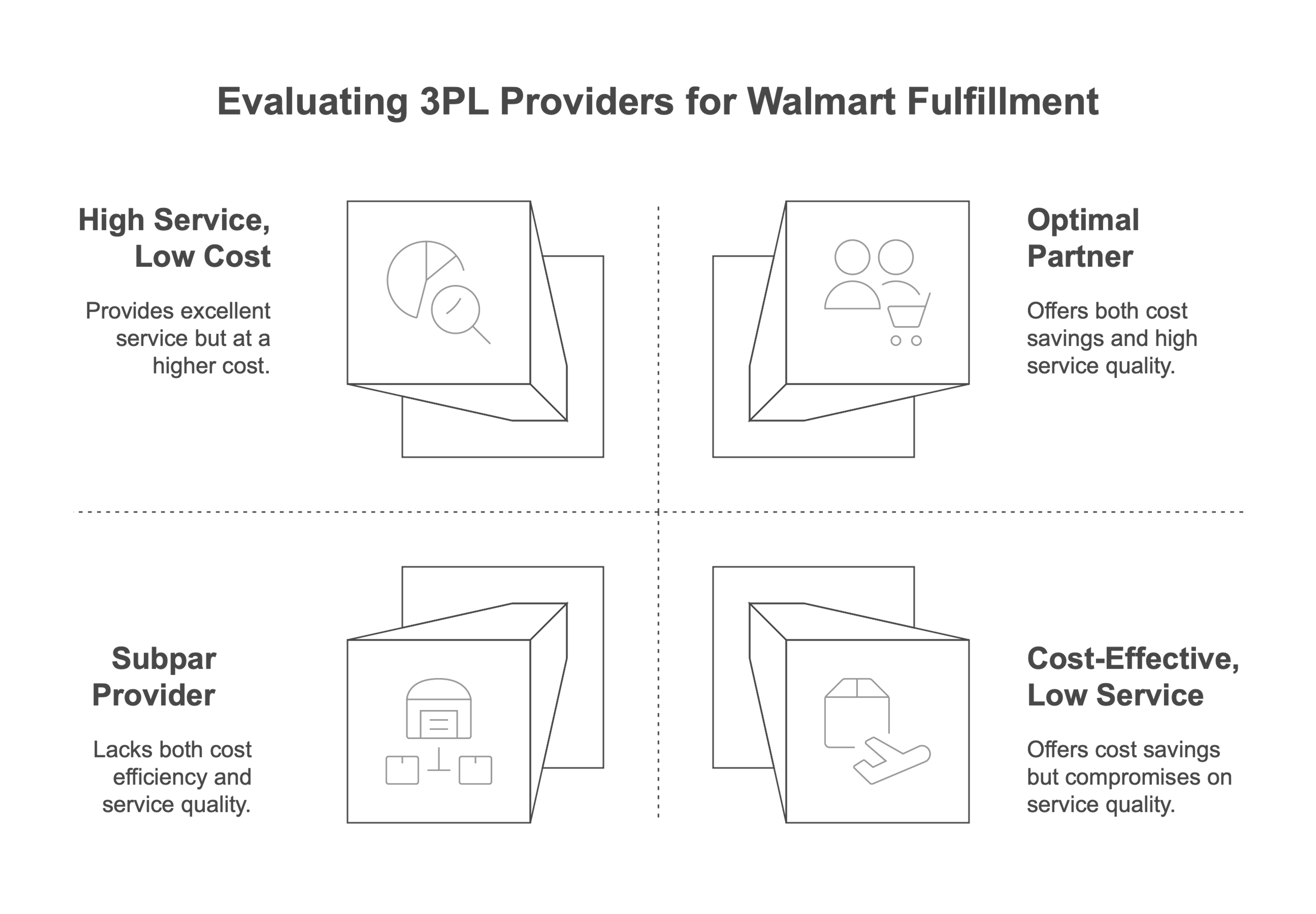/Tips for Using a 3PL for Walmart Fulfillment

Tips for Using a 3PL for Walmart Fulfillment
As an eCommerce seller, fulfilling orders efficiently and cost-effectively is crucial to your business’s success. Walmart Marketplace presents a fantastic opportunity to reach millions of potential customers, both online and in store, but meeting Walmart’s strict fulfillment requirements can be challenging. This is where partnering with a third-party logistics (3PL) provider can be a game-changer. A well-chosen 3PL can help you optimize Walmart logistics, reduce costs, and ensure compliance with Walmart’s standards.
In this comprehensive guide, we’ll explore the essential tips for using a 3PL for Walmart fulfillment, covering everything from selecting the right provider to managing compliance and efficiency.
Understanding Walmart Fulfillment Requirements
Before diving into the role of a 3PL, it’s crucial to understand Walmart’s fulfillment requirements. Walmart Marketplace has stringent performance metrics that sellers must adhere to, including:
- On-Time Shipping: Walmart expects orders to be shipped within the agreed-upon timeframe, usually within two business days for standard orders.
- Fast Delivery: To remain competitive, fast and reliable shipping options are essential.
- Low Order Defect Rate (ODR): Walmart closely monitors order cancellations, delayed shipments, and customer complaints.
- Accurate Tracking: Orders must have valid tracking information to ensure transparency and reliability.
- Efficient Returns Handling: Walmart requires sellers to have a straightforward and efficient return process.
A 3PL can help you meet these requirements, but only if you select and manage the right provider effectively.
What is 3PL and its Role in Ecommerce Business
Third-Party Logistics (3PL) providers play a pivotal role in the eCommerce business landscape by offering outsourced logistics and supply chain management services. These providers handle a wide array of logistics tasks, including inventory management, warehousing, shipping, and fulfillment. By partnering with a 3PL, eCommerce businesses can offload the time-consuming logistics processes to experts, allowing them to concentrate on core activities such as marketing, product development, listing optimization, and customer engagement.
3PL providers bring specialized knowledge and resources to the table, ensuring that inventory is managed efficiently, orders are fulfilled accurately, and shipments are delivered on time. This partnership not only streamlines operations but also enhances the overall customer experience, making it a strategic move for businesses looking to scale and optimize their supply chain.
Benefits of Outsourcing Logistics to a 3PL
Outsourcing logistics to a 3PL provider offers numerous advantages that can significantly benefit eCommerce businesses. Here are some key benefits:
- Cost Savings: 3PL providers have established relationships with carriers and warehouses, enabling them to negotiate better rates. These cost savings are passed on to eCommerce businesses, reducing overall logistics expenses.
- Increased Efficiency: With their expertise and resources, 3PL providers can manage logistics processes more efficiently. This results in faster order fulfillment and reduced errors, ensuring that customers receive their orders promptly and accurately.
- Improved Customer Satisfaction: By ensuring quick and accurate order fulfillment, 3PL providers help eCommerce businesses deliver a superior customer experience. Satisfied customers are more likely to become repeat buyers and recommend the brand to others.
- Scalability: 3PL providers have the infrastructure and expertise to handle fluctuations in order volumes. Whether it’s a peak season or a promotional surge, they can scale operations seamlessly, allowing businesses to grow without logistical constraints.
By leveraging the capabilities of a 3PL, eCommerce businesses can enhance their operational efficiency, reduce costs, and provide better service to their customers.
Selecting the Right 3PL for Walmart Fulfillment
Choosing the right 3PL provider is a critical decision that can significantly impact your Walmart Marketplace success.

Here are key factors to consider:
1. Walmart Marketplace Experience
Look for a 3PL with direct experience handling Walmart orders. Some 3PLs specialize in Amazon or other marketplaces, but Walmart has unique requirements that your provider must be familiar with.
2. Compliance with Walmart’s Standards
Ensure the 3PL has a track record of meeting Walmart’s fulfillment policies, including on-time shipping, accurate order tracking, and proper packaging.
3. Multi-Warehouse Capabilities
To offer faster delivery across the U.S., choose a 3PL with strategically located fulfillment centers that can help store inventory efficiently, reducing shipping costs and transit times.
4. Integration with Walmart’s Systems
A good 3PL should seamlessly integrate with Walmart’s Seller Center and other necessary software, ensuring real-time inventory management and order tracking.
5. Scalability and Flexibility
Your business may experience fluctuations in demand. The 3PL should be able to scale operations efficiently to handle peak seasons, promotions, and unexpected surges.
6. Competitive Pricing
Compare the pricing models of different 3PL providers. Efficiently storing inventory can help reduce storage fees and overall logistics expenses. Consider storage fees, pick-and-pack fees, shipping costs, and any hidden charges to ensure profitability.
“Success with Walmart fulfillment hinges on speed and compliance. Unlike Amazon, Walmart prioritizes two-day delivery for its Marketplace sellers, making warehouse location and carrier integration critical. Sellers should optimize inventory distribution to meet these expectations while keeping costs in check.” - Tom Wicky, Co-founder of MyFBAPrep
Setting Up Your 3PL for Walmart Fulfillment Success
Once you’ve selected a 3PL, the next step is to ensure seamless collaboration. Here are the essential steps to set up your partnership for success:
1. Establish Clear Communication
Effective communication with your 3PL is vital. Define key performance indicators (KPIs), expectations, and reporting structures to keep everything on track.
2. Ensure Proper System Integration
Work with your 3PL to integrate their software with Walmart’s systems to enable real-time order tracking, inventory synchronization, and automated fulfillment updates.
Walmart Fulfillment Services (WFS) simplifies operations by managing storage, packing, shipping, and customer service.
3. Optimize Inventory Management
To avoid stockouts or overstocking, collaborate with your 3PL to implement efficient storing practices, demand forecasting, and inventory replenishment strategies.
4. Set Up Efficient Returns Handling
Returns are inevitable in eCommerce. Make sure your 3PL has a clear returns management process that complies with Walmart’s policies.
5. Test Before Scaling Up
Before committing large order volumes to your 3PL, run test shipments to ensure quality control and adherence to Walmart’s fulfillment guidelines.
Overview of 3PL Fulfillment Process and Services
The 3PL fulfillment process is designed to ensure that orders are processed efficiently and accurately. Here’s a step-by-step overview of how it typically works:
- Receiving: The 3PL provider receives inventory shipments from the eCommerce business and logs them into their system. This step involves checking the received items for accuracy and quality.
- Storage: The inventory is then stored in the 3PL provider’s warehouse. Items are securely packed and organized for easy access, ensuring that they are ready for quick retrieval when orders come in.
- Picking: When an order is placed, the 3PL provider picks the relevant items from the warehouse. This step involves locating the items and preparing them for packing.
- Packing: The picked items are securely packed to ensure they are protected during transit. The 3PL provider uses appropriate packaging materials and techniques to minimize the risk of damage.
- Shipping: The packed orders are shipped to customers using various carriers and shipping options. The 3PL provider ensures that the shipping process is efficient and that customers receive their orders on time.
- Returns: The 3PL provider also handles returns and refunds. They manage the return process smoothly, ensuring that returned items are processed and restocked efficiently.
By managing these steps, 3PL providers help eCommerce businesses streamline their fulfillment process, ensuring that customers receive their orders quickly and accurately.
Maximizing Efficiency with Your 3PL
Efficiency is the key to maintaining a competitive edge on Walmart Marketplace. Here’s how to ensure your 3PL is operating at peak performance:
- Monitor Key Metrics Regularly: Track important KPIs such as order accuracy, shipping speed, and return rates to ensure your 3PL is meeting Walmart’s standards.
- Leverage Data Analytics: Use data insights to optimize fulfillment strategies, identify trends, and improve overall performance.
- Negotiate Shipping Rates: Many 3PLs have partnerships with major carriers. Negotiate better shipping rates to reduce costs and offer competitive pricing to customers.
- Utilize Walmart’s Free Two-Day Shipping Program: If possible, enroll in Walmart’s Two-Day Shipping program to boost your visibility and sales by leveraging Walmart’s extensive reach in both physical stores and its online marketplace, benefiting from the seamless integration of shopping experiences for consumers.
- Stay Updated on Walmart’s Policies: Walmart’s fulfillment requirements can evolve. Stay informed and ensure your 3PL adapts accordingly to maintain compliance.
Value-Added Services and Technology Offered by 3PL Providers
Beyond core fulfillment services, 3PL providers offer a range of value-added services and technology solutions that can further enhance the efficiency and scalability of eCommerce businesses. Some of these include:
- Inventory Management Software: Advanced inventory management software systems help businesses maintain optimal stock levels, reducing the risk of stockouts or overstocking. This ensures that the right products are available when customers need them.
- Climate-Controlled Warehousing: 3PL providers offer secure and efficient warehousing services, and some provide additional services for temperature-sensitive products. They ensure that inventory is stored safely and is easily accessible for quick order fulfillment.
- Shipping and Logistics: From same-day shipping to expedited LTL (Less Than Truckload) shipping, 3PL providers offer various shipping options to meet different customer needs. They leverage their logistics expertise to ensure timely and cost-effective deliveries.
- Customer Service: Many 3PL providers offer customer service support, helping businesses manage customer inquiries and issues related to order fulfillment. This ensures that customers receive the assistance they need promptly.
- Technology Solutions: 3PL providers often offer advanced technology solutions, such as order management systems, inventory management software, and shipping software. These tools help businesses automate and streamline their logistics processes, improving overall efficiency.
By taking advantage of these additional services and technology, eCommerce businesses can optimize their operations, enhance customer satisfaction, and scale their business more effectively.
“Seller-fulfilled models offer greater control over inventory, branding, and customer experience. By bypassing strict fulfillment center rules, brands can manage costs more effectively and scale with flexible fulfillment partners, especially in categories with unique packaging or temperature-sensitive products.” - Tom Wicky, Co-founder of MyFBAPrep
Common Pitfalls to Avoid When Using a 3PL for Walmart Fulfillment
While a 3PL can significantly streamline your fulfillment process, there are potential pitfalls to watch out for:
- Lack of Transparency: If a 3PL does not provide real-time tracking and clear communication, it can lead to order delays and customer dissatisfaction.
- Poor Inventory Management: Failure to track stock levels accurately and storing inventory efficiently can lead to stockouts or excess inventory, hurting your Walmart seller performance.
- Slow Response Times: A slow or unresponsive 3PL can damage your seller ratings. Choose a provider with strong customer service and quick resolution capabilities.
- Hidden Fees: Some 3PLs have unexpected costs. Always review contracts carefully and clarify any potential hidden charges.
“Many sellers overlook the hidden costs of fulfillment—storage fees, long-term holding costs, and return processing. Whether using Amazon, Walmart, or third-party logistics, brands should regularly audit fulfillment expenses to ensure they are balancing cost with service level expectations." - Tom Wicky, Co-founder of MyFBAPrep
Final Thoughts
Using a 3PL for your Walmart fulfillment services can be a game-changer for your eCommerce business. However, success depends on selecting the right provider, ensuring compliance with Walmart’s policies, and continuously optimizing fulfillment operations. By following these tips, you can leverage a 3PL to improve efficiency, reduce costs, and scale your Walmart Marketplace business effectively.
Whether you’re new to Walmart Marketplace or looking to optimize your fulfillment strategy, a well-managed 3PL partnership can help you meet customer expectations and achieve long-term success.


